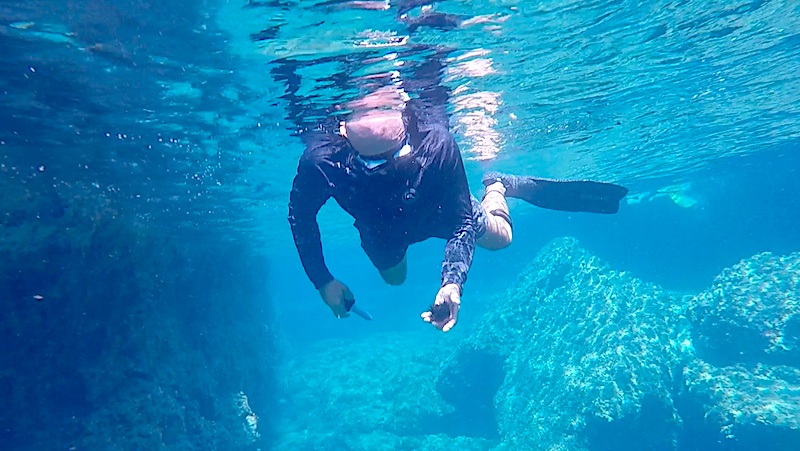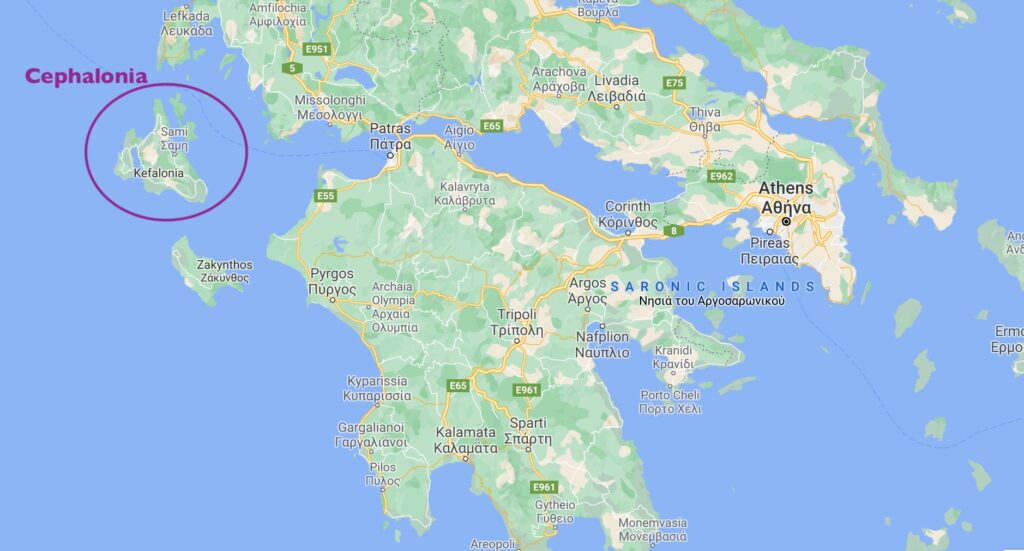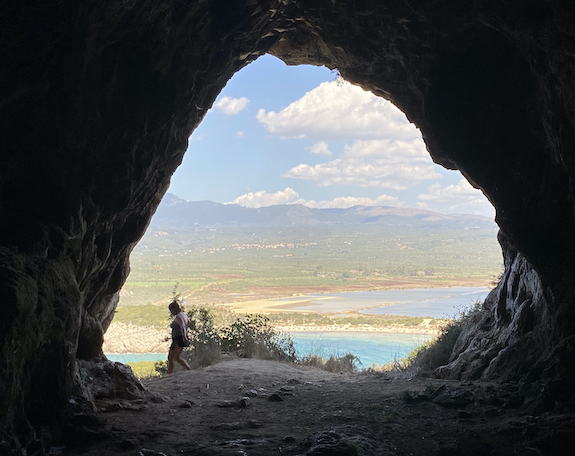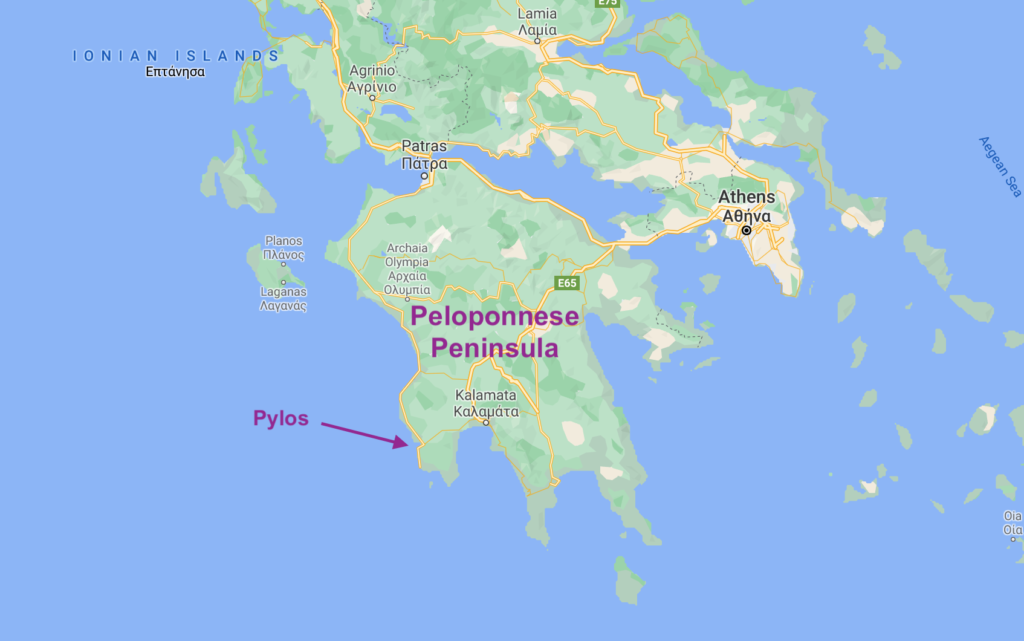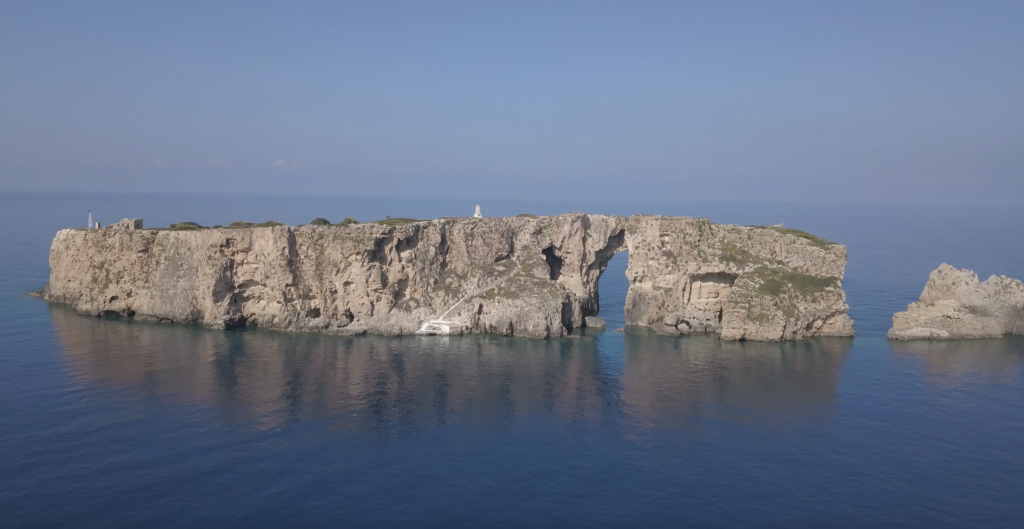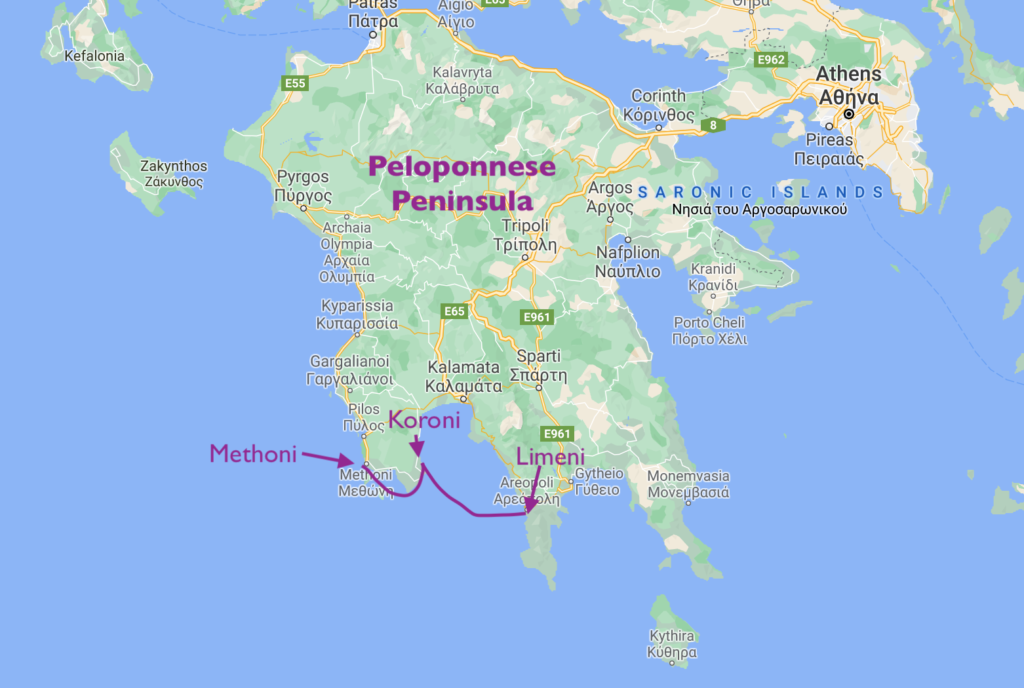The summer winds in the Ionian Sea are by-and-large quite mild. When it does blow, the wind comes onshore from the west. Therefore, most of the favorable, comfortable anchorages are on the eastern side of the islands. Cephalonia was no exception, with a range of options between quaint and bustling. As we motored into Poros under glassy calm seas, and we were the only boat in the anchorage, the town was feeling much more on the quaint end of the spectrum. A pronounced V-shaped gorge was cut into the ridge behind the town, hinting at a large valley inland and many decades of heavy spring runoff. A few multi-story buildings lined the shore, but otherwise, a long uninterrupted beach greeted us as we landed with the dinghy. Cephalonia was lining up to be a chill, low-key island, about as much of a polar opposite to Mykonos as one could get. A few teenage boys explored the rocky shallows, appearing to care less about what they might find and more about the simple companionship of a friend. Or perhaps Mom kicked them out and told them not to return until dinner time!
Continue reading “Love, In All Its Forms, Ep. 142”Youth and the Uni-effect, Ep. 141
There should be no shame in a Plan B. Sure, there’s the difficulty in accepting one’s fallibility. But we’ve found that if we think ahead about possible Plan B’s, it’s easier to make the switch when Plan A develops an attitude. And, an attitude was what we were faced with as we rounded the northern tip of Zakynthos for Shipwreck Beach. As soon as we pointed Sea Rose towards the alternative of neighboring Cephalonia, the sea sickness subsided and the curiosity about a new island emerged.
A Final Peak at the Peloponnese, Ep. 139
A couple of years ago, when Samuel Adams started hawking their ‘West Coast Style’ Rebel IPA, I was intrigued. Here I was a California-born living in Samuel Adams country on the East Coast. What could be a better beer to drink? If only one could solve the riddle of what ‘west coast style’ really meant. Beer aficionados touted its hoppier hops, but to a mere commoner like me, it was just a simple IPA. As we pointed Sea Rose up along the west coast of the Peloponnese peninsula, I wasn’t going to let a catchy marketing cliche get in the way of appreciating this region’s unique west coast style. If it meant a little beer tasting along the way, all the better!
The Eyes of Venice, Ep. 138
It might help if you scrounge around ahead of time for the ouzo in the back of your liquor cabinet, but when I look at the layout of the Peloponnese coastline and bays, it reminds me of the profile of an American Bison, grazing on the plains of Yellowstone National Park. And with that spirit of the Wild West, we set off westbound from Limeni to cross the last 20 miles of open water to the port of Koroni.
A Transformative State of Mind, Ep. 137
The Peloponnese landmass branches out into three prominent peninsulas on its southern shore, forming two long, deep bays. These peninsulas are barren, dry landscapes, with steep ridge lines running their length, reminding me of the spiny, crusty back of a Tyrannosaurus rex. And perhaps it is the threat of a T-rex emerging from the dead that keeps the general populous away from this region of Greece. Or the lack of roads. What remains is a number of small villages and, in the summer, a preponderance of mini-campers driven by modern day hippies trying to find a momentary escape from contemporary living. Perhaps there were a couple people onboard Sea Rose looking for a bit of the same.
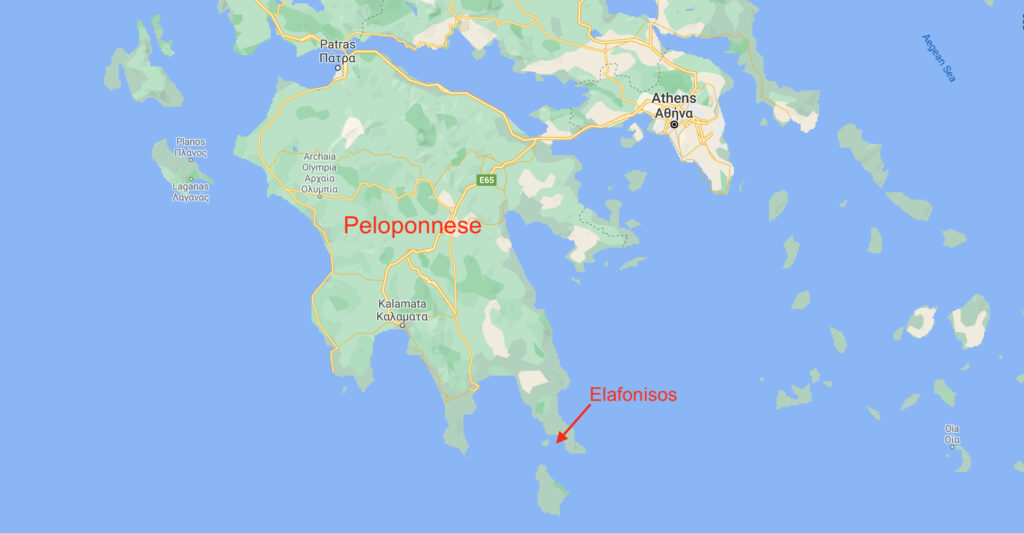
We launched our exploration of these deep bays and peninsulas after an early morning departure from Elafonisos. I was hoping that the concentration of large motor yachts around the corner were not going to hinder our escape from a contemporary state of mind. Thankfully, the four hour trip across calm flat seas to the Mani peninsula and the port of Kayio was blissful – dare I say transformative. After so many days of high winds and nasty seas, it was magical to rediscover sailing in benign weather.
Continue reading “A Transformative State of Mind, Ep. 137”The Grand Gramvousa Island in Northwest Crete, Ep. 135
As is typical for much of Greece, morning winds are lighter than afternoon. If you need to go up-wind, it is best to leave early. At 7 am on the morning we would make our way to the northwest tip of Crete, we were tossing off our stern lines, raising our anchor and heading out of the charming harbor of Chania. The winds had been erratic and strong for the previous couple days, so we expected it to be a rough trip.


Searching for the Soul of Crete, Ep. 133
We were interviewed recently by Jeanneau America for an expose on what owners do and see with their boats. As we sat on the shores of Newport, Rhode Island, explaining our exploits in the U.S. onboard Thalia, and now onboard Sea Rose in the Mediterranean, our host Paul remarked on how we must be big planners to accomplish these sailing goals. And in general Karen and I are pretty serious task masters, fortified by our many years in corporate America working to get project teams focused in a common direction. But as we awoke at dawn inside the caldera of Santorini, and pointed the bow of Sea Rose south, we were living like carefree teenagers. Crete, about 65 miles distant, was big, downwind, and a place we knew nothing about. So we decided to sail there. Simple as that!
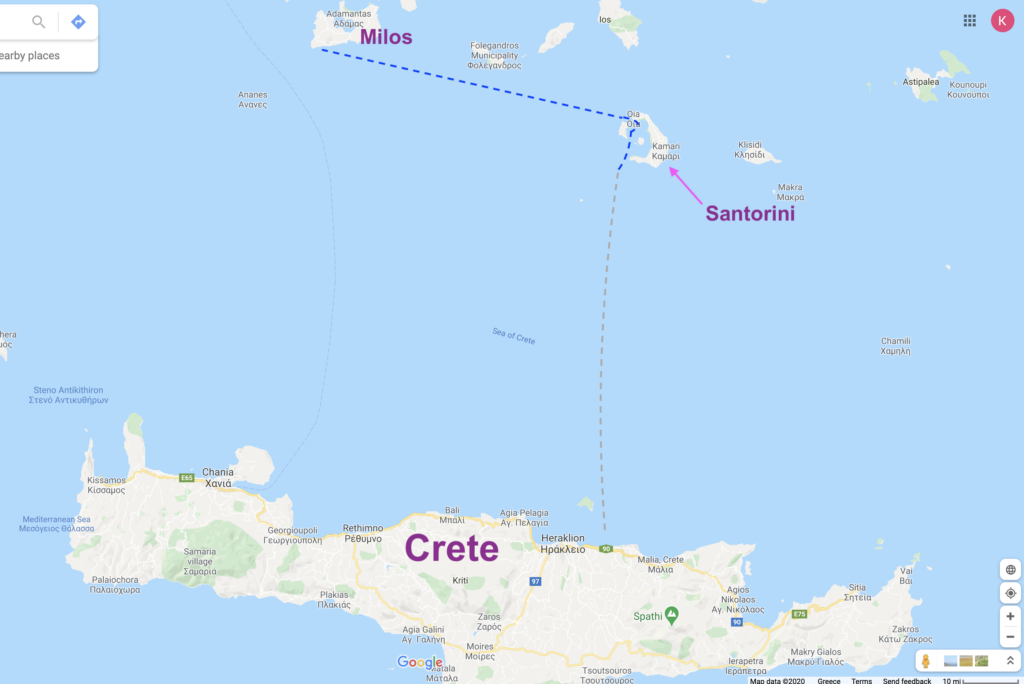
Many destinations had been out of scope for our westbound march out of Greece, in the pre-Covid19 planning talks we had over the winter. But this was a new game. We weren’t going to make it to the English Channel by the end of this summer as originally intended, and Greece was taking good care of us, so we dialed back our hit list, with a determination to see more of the Greece we loved.
Crete is a part of Greece, but like other large islands owned by mainland parents such as Corsica and Sardinia, the Cretans have a loyalty to their island first, and to the greater Greece nation second. It’s not like they harbor any animosity towards Athens. Their island has been fought over and occupied by far too many foreign powers, even by European standards. There were the Byzantines, the Romans, the Venetians, the Arabs, the Ottoman Turks, the Germans during WWII, to name just a few. Yet, the Cretans were some of the first to send personnel to fight for the Greek War of Independence starting in 1821. Ironically, major civilization on the island started with the Minoans, who were renowned for their peace-loving nature. We were to tour the remains of the Minoan palace of Knossos in a few days and revel in the fact that very little in the way of defensive equipment – forts, castles, spears, cannons – were found during the archaeological digs. I couldn’t wait to discover this island and understand further it’s contrasts and contradictions.
We unfurled the jib and tried motorsailing, as the dramatic silhouette of Santorini faded to our rear. Before long the forecasted northwesterlies kicked in and allowed us to replace the engine with full main, jib and a splendid 6 knots of beam-reaching speed. Indeed, we put the boat on autopilot and had to do very little in the way of sail trimming, as the steady 10-15 knots of NW wind blew blissfully all day, until we were within 5 miles of the Cretan coastline. Not since we had entered the Aegean had we been given a gift of such pure and easy sailing.
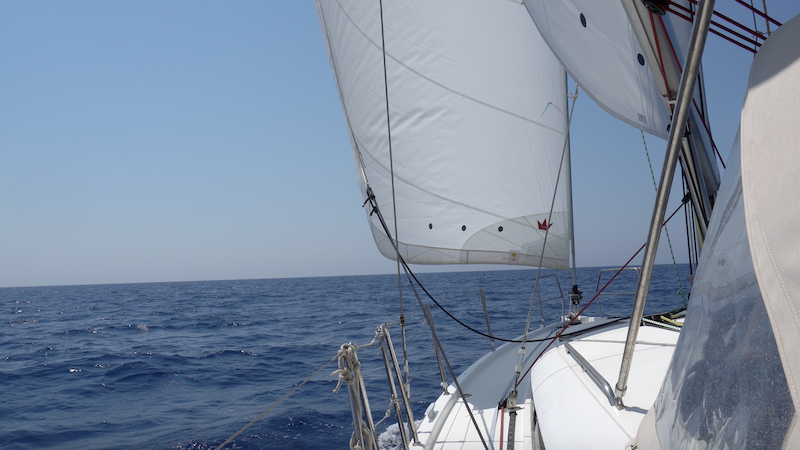
As we motored the final approach into Porto Gouves, a small privately run marina affiliated with an adjacent hotel complex, we were warned by the lone marina attendant to stay close as we rounded the breakwater-protected entrance. This was sage advice, especially for a pair of attention-fatigued captains who had been on the water all day. Large breakers crashing onto the town beach were just a boat length to our port side, ready to swallow us up if we didn’t execute our turn properly. This was all exacerbated by the fact that, with me on bow watch yelling back to Karen to ‘stay 10 meters off the breakwater’, Karen thought I meant to ‘stay at least 10 meters off the breakwater’, a prudent approach near most breakwaters where the boulders and rip-rap can extend out further underwater, like the hidden underwater dangers of an iceberg. But in fact I meant to say no further away than 10 meters, as the marina attendant warned me it got very shallow near the beach breakers. We got on the same page quick enough, but it reminded me of cockpit voice recordings between pilot and co-pilot right before a crash. We vowed to be more specific in our wording, and in these critical situations, to ask the other to repeat the directions back as a form of confirmation.
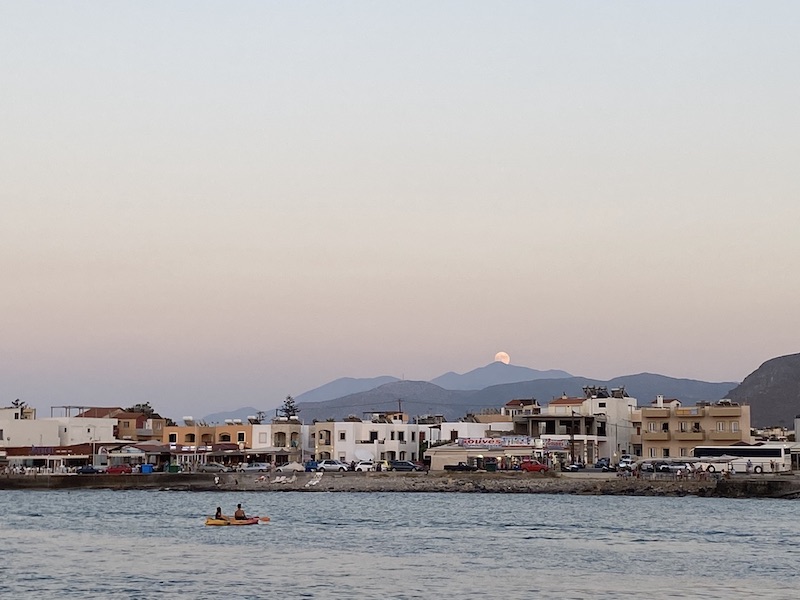
The Porto Gouves marina looked like a scene from ‘The Day After Tomorrow’, with only three other boats in the water, weeds growing up in the cracks on the pier, and a vacant and dark hotel building across the frontage road, having never opened for the session. After weeks of crashing into big seas under reduced sail in the Aegean, Sea Rose was coated everywhere with salt, and we took advantage of the unlimited water supply to thoroughly wash down the entire exterior, giving the salt no respite from our high pressure hose. Finally, Sea Rose was back to being a proper lady again. Whenever we do these big cleanups and re-provisioning at a marina, my thoughts shift to an expedition party coming back into civilization from the wilds of the backcountry. We are largely self-sufficient onboard Sea Rose which allows us to explore remote anchorages and make long passages to experience the beauty of Mother Nature up close, both above and below the water. But every once in a while, we need to come in from the wild to clean and stock up. We did it more often last year, with a lot of friends coming on a weekly turn to meet us at a marina, and when we do this, I long for the day when we can get back out ‘there’.
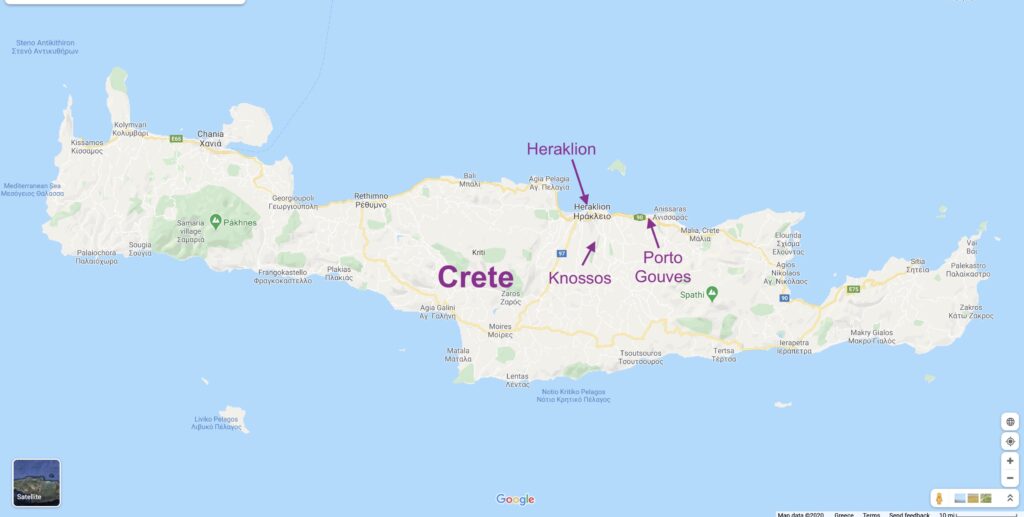
We rented a car from Caroline’s Travel Store, a women who effortlessly switched between five languages to help her customers, and we headed inland to find the archaeological site at Knossos, the main tourist attraction in this part of Crete. We hit the road early to avoid reports of large bus groups, and to avoid the heat of the mid-day. At the entrance, we heeded more advice and hired a guide, and soon I was as much intrigued by the history as I was about this charming little old lady Eva. Knossos is the most well known of the Minoan settlements on Crete, a palace originally constructed in 2000 B.C. and then expanded in 1700 B.C. These dates alone caused me to pause and reflect. I’m 57 years old. The stones upon which I walked, and the remaining walls and courtyards that Eva lovingly interpreted for us, were older than 65 of my lifetimes! And, from all accounts, the Minoans were a peaceful society, where they carved out a life on Crete with a population back then greater than that currently on the island! Life seemed pretty primitive to me, dare I say primeval, just 100 years ago. There were no cell phones, no internet, no refrigeration. The light bulb had just been introduced, flights at Kitty Hawk had just been launched, and the Model T was early in it’s production run, with the horse and buggy still prominent. Yet, the Minoans, 3700 years ago, had found a way to develop and sustain a safe, economically viable society. Less than 100 years ago, we had had two world wars and came close to annihilating our entire species with mutually-assured nuclear destruction. Too often, we toss aside the knowledge and expertise of prior civilizations, despite the clear evidence of a highly advanced culture, able to survive socially and economically in the absence of all the comforts and conveniences we have available today.

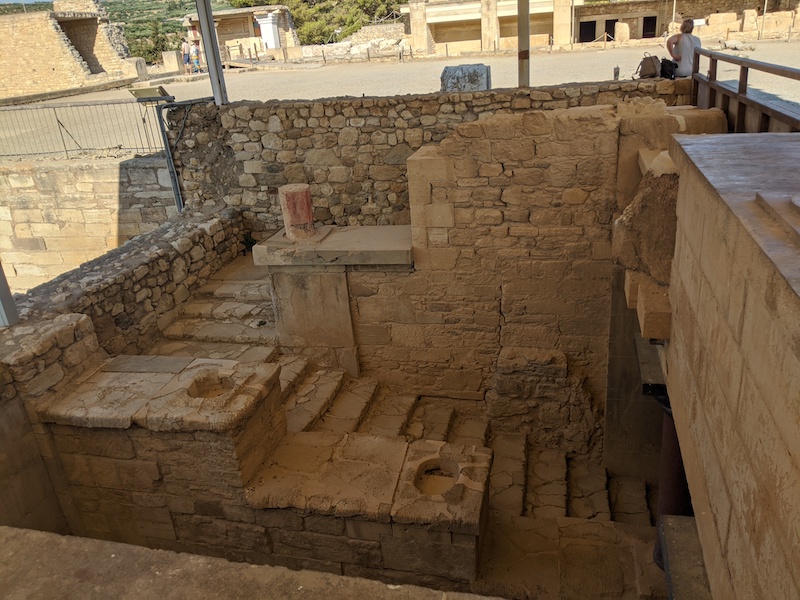
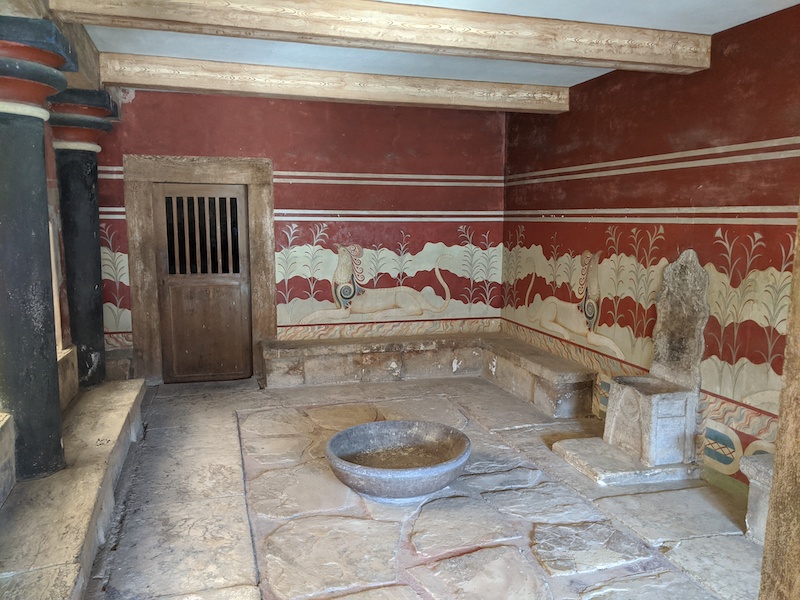
In front of me were the remains of a four-story palace, and again, I was left bewildered. A single story building would seem like a challenge back then, in the absence of modern mechanization and hand tools. We need to re-evaluate our own self image as a superior society and dig for the lessons to be gleaned from these ancient yet advanced civilizations.
Bidding adieu to Eva, we went in search of the latest advances in wine making techniques on Crete. The island has an extremely tall mountain range that runs down the middle of the island, with fertile valleys throughout the northern interior. In recent times Crete has become well known for it’s respectable wines. Regrettably, Google maps has not kept up with the trend, and we took our rental car on a safari of sorts, with Google taking us off the main paved roads on a back wrenching pot-holed, stones-as-big-as-bowling-balls, ride over dirt roads. At one point, we had to abandon the car on the edge of a hillside vineyard and climb the rest of the goat path by foot, discovering a perfectly respectable road leading into the spacious winery parking lot! On our second stop, at Titakis winery, we were hosted by a cheerful young woman, Eleni, who had recently finished her wine studies in Athens and returned to her home in Crete to share enology responsibilities with the founder. The wine locker on Sea Rose hadn’t seen such a boost in inventory since our travels around the interior of France!
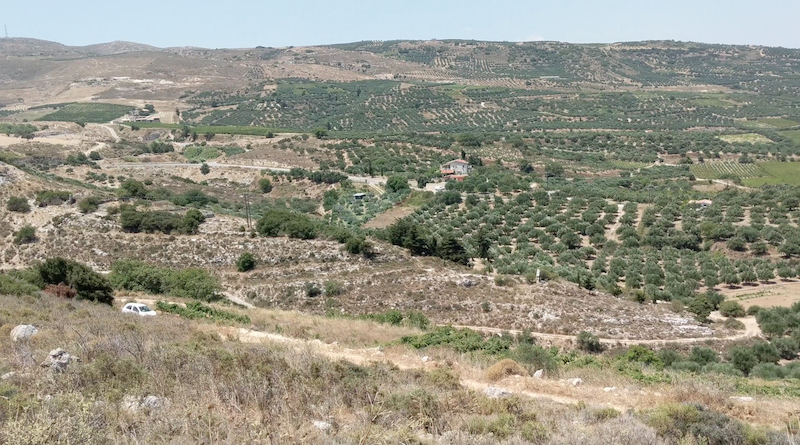

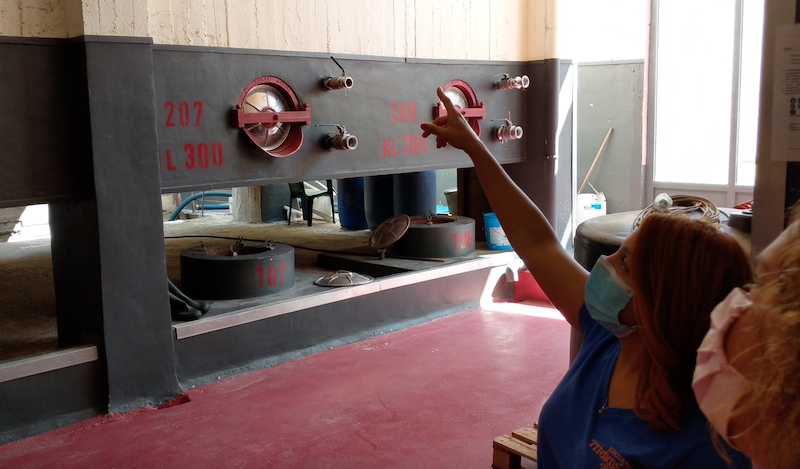
Our rental car wanderings took us to the nearby city of Heraklion, the nerve center of the island, and with a surprising number of flights landing and taking off despite the pandemic. We chose to duck the mid day heat by attending the archaeological museum with its many restored artifacts from Knossos. But I must confess, wearing a mask for extended periods, even inside buildings here, is a fatiguing, sweaty affair. I couldn’t wait to walk through the exit doors and into the heat but mask-free world. We had been told to not expect too much from this big city, and as we walked part of the waterfront, there was no mistaking this was a rough and ready town. The one notable piece of eye candy was the Venetian harbor. Along many of these northern cities, you will find a big modern harbor enclosing a small, shallow, often nearly round inner harbor, built by the Venetians. Often adorned with a tower or full-on castle at the entrance, their diminutive size and depth can make them unsuitable for most larger craft, giving one the advantage of appreciating their beautiful construction absent the super yachts and the associated over-commercialization. The Venetians also put their handicraft to work building showcases of long arched-roof stone boat houses, many of which still ringed the harbor, some converted for modern use, others left to age gracefully.
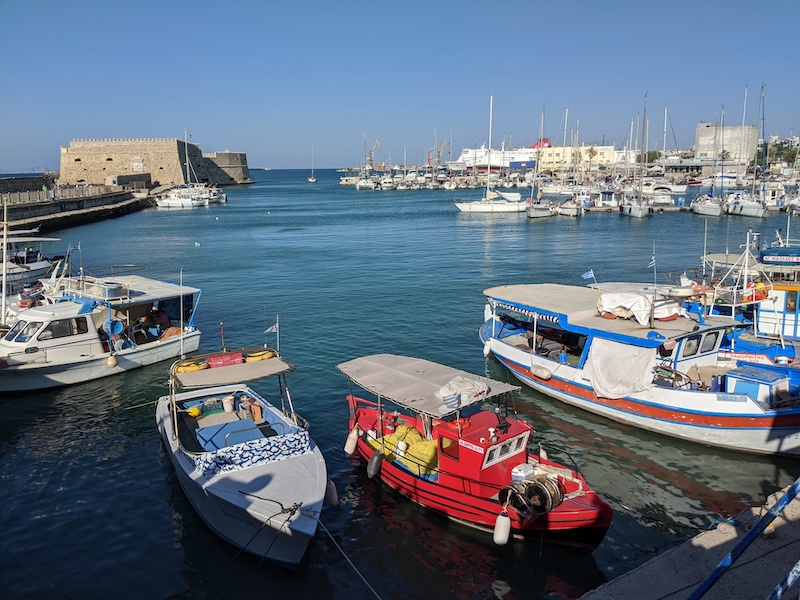
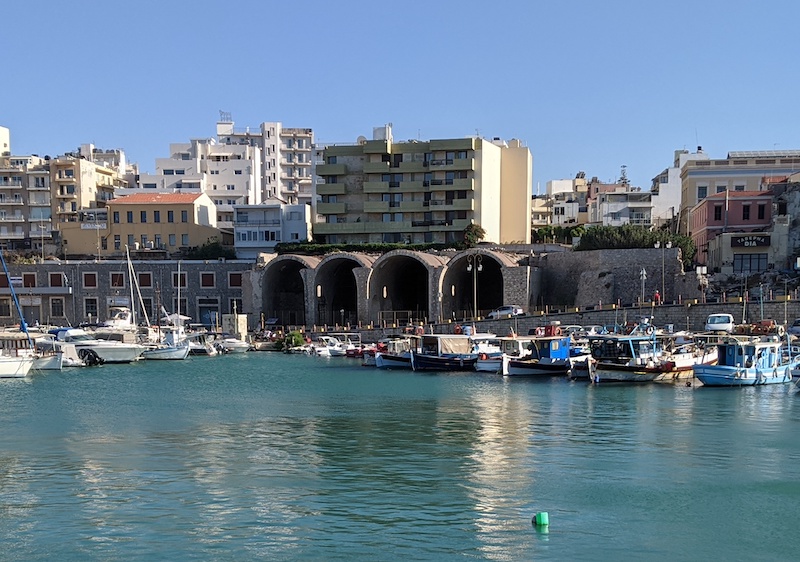
With our first impressions of Crete firming implanted in our memory, it was time for us to make our way west along the northern coast. From this mid-point, the next major harbor of Rythimno beckoned. Our craft – clean and bright and re-provisioned – was ready and willing to take her curious caretakers onward. Crete – that big, odd island at the bottom of Greece – was starting to unfold its treasures before our eyes, and we were eager to take it all in.
Be Open to the Unexpected, Ep. 131
This blog post covers our departure from Donousa, a stop along Naxos’s south coast and ends with stunning Milos and the nearby islands of Palaigos and Kimolos.
Some stops are nothing more than functional … 100% utilitarian, with little to no entertainment value and that’s just how it is! This should be fine, right? However, it is easy for all of us to get caught up in wanting an amazing experience at every turn. We really struggle when we have friends or family on board because they only have a week and we want each day to be full to the point of overflowing with sights and activities; we hope that each evening’s anchorage will be beautiful and memorable – yet one without drama where we can all get a restful night’s sleep. If you have spent any time living on a sailboat or going on an extended driving trip, you know how hard it is to balance moving along on your planned, longer-term route while also having enriching or exciting experiences.
I was looking at the current portion of our summer’s journey as something to tolerate between special stops. We had recently left the amazing islands of Samos, Patmos and Arki and we were headed toward renown Milos but we had at least two stops along the way. However, the first of these stops was in Roussa Harbor on Donousa – the final island Tom covered in the previous blog – and it was a very pleasant surprise and a place I would hate to categorize as functional. We had a beautiful anchorage with calm seas in the large, protected bay as the wind was wild just outside and the busy, welcoming taverna fed our souls as well as our bodies.

Love Thy Siesta, Love Thy Sister, Ep. 130
There are not many marine preserves in Greece – in fact, not many in the entire the Med – but we set our course for the island of Arki, a soon-to-be ratified part of the North Dodecanese Wildlife Refuge, and a short distance from Leros where we had started from just a week ago. I wasn’t sure what to expect from a protected area in Greece, but our arrival in the calm harbor of Port Augusta answered any doubts I had. Here was an only slightly larger version of the charming little village of Agathonisi that we had visited last week. Approaching the small town quay, we could see plenty of space around the few boats already med moored to the quay. After the warmup at Agathonisi, Karen was in natural form as she turned Sea Rose around and began backing into the quay as I lowered the anchor. Med mooring with two people is a bit tricky, as you can really use a third person to manage tying the stern lines to the quay. Thankfully, a gentleman from a nearby boat wandered over and helped with that task. And the reduced breeze reduced the stress level as well.
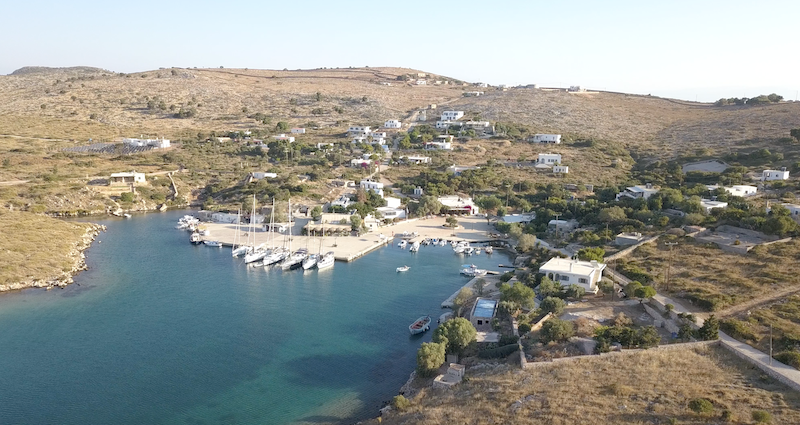
Boat Projects in Paradise – Ep. 129
It was July 15th when we were finally underway for this pandemic-impacted sailing season. There were far more unknowns to contend with this year but since we already acted on the tough decision to come to Europe amid all the potential for new and changing travel restrictions we had to dive in and start exploring. This summer would be an exercise in flexibility … and not of the musculature type!
For our first night away from Sea Rose’s winter home, we set our course for Agathonisi, a short trip to a small island to the NE of Leros. Being early season, we have a list of projects that would steal our time over the coming days, so picking a place close by seemed perfect. Being afternoon when we finally departed the boatyard, we immediately experienced high winds and quickly found ourselves flying past small islets at 9 kts of boat speed. I hope we’re ready for this wild ride!
Continue reading “Boat Projects in Paradise – Ep. 129”

